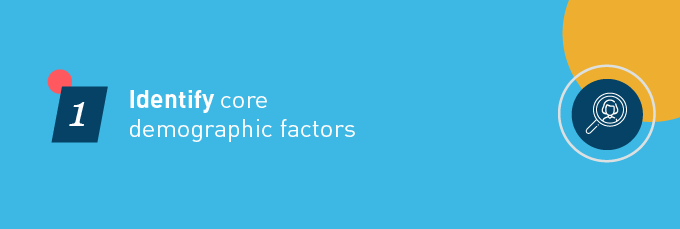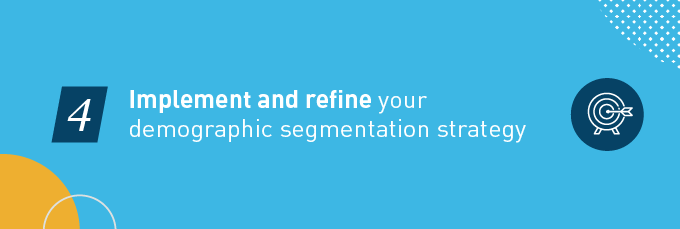
Imagine you’re a master chef preparing a sumptuous feast. As you gather your ingredients, you know that the key to a delectable dish lies in understanding the flavours and tastes of your diners. Similarly, in the world of digital marketing, effectively reaching and engaging with your target audience requires a deep understanding of their demographics – the crucial ingredients that make up their preferences, behaviours, and desires.
This article will outline four essential keys to building and comprehending demographic information for more accurate and impactful targeting, elevating your marketing efforts to new heights.

1. Identify core demographic factors
The first step in building a comprehensive demographic profile is determining the core factors that best represent your target audience. These factors will help segment the market for more effective targeting of your marketing efforts.
Core demographic factors include:
Age
Age is a critical component in shaping consumer preferences, purchasing behaviours, and engagement patterns. Segmenting your audience based on age groups allows you to tailor your content and promotional strategies to resonate with each generation’s unique characteristics and preferences. It also helps build lasting and meaningful relationships with your potential buyers.
Gender
Understanding the preferences and decision-making processes of male and female consumers is vital to tailor your marketing efforts. Gender-based targeting can significantly impact the communication style and emotional appeals that resonate with different audiences.
Income
Income levels influence purchasing power, making it crucial for marketers to create targeted messaging that suits various income brackets. Understanding the financial capacities and limitations of your demographic segments allows you to craft value propositions that cater to the audience’s budgetary expectations.
Location
Geographic location affects consumer behaviour due to factors such as climate, culture, language, and lifestyle. Accurate targeting based on location helps you create more relevant marketing content that reflects the unique needs and expectations of consumers in specific regions.

2. Gather and analyse demographic data
Once you’ve identified the core demographic factors, the next step is to gather and analyse relevant data to create detailed audience profiles. Some effective methods for gathering this data include:
Surveys, questionnaires and interviews
Conducting surveys or questionnaires can provide direct insights into your target audience’s preferences, behaviours, and motivations. You can use online survey tools or engage your email subscribers to gather demographic data and feedback. Any creative content will also benefit from user interviews.
Website and social media analytics
Utilise web analytics tools like Google Analytics and social media analytics to analyse your audience’s demographics and behaviours, including geographical information, browsing patterns, and interests.
Market research
Research industry reports and studies to gain insights into consumer trends, preferences, and behaviours. Market research can help you identify gaps in the market and provide a more comprehensive understanding of your target audience.
Customer database analysis
Examine your existing customer database to identify commonalities in demographic profiles, purchase patterns, and preferences. By analysing your customer base, you can uncover insights that help inform your marketing strategies for captivating content campaigns.

3. Refine your buyer’s persona
With a solid foundation of demographic data, you can construct a highly detailed buyer’s persona that reflects your ideal customer. A well-developed buyer’s persona enables you to visualise and empathise with your target audience, making it easier to align your marketing efforts with their needs and expectations. Essential components of an effective buyer’s.
Demographic information
Incorporate the core demographic factors identified earlier to create a comprehensive picture of your ideal customer. This information will help you better understand the unique characteristics of your target audience and inform your targeting strategies.
Goals and challenges
Consider the personal and professional objectives and struggles that your target audience faces. This information can highlight the pain points that your products or services could address, providing value to your customers and differentiating your brand in the market.
Motivations and influences
Identify the factors that drive your target audience’s purchasing decisions, including personal values, beliefs, and peer influences. By understanding your audience’s motivations, you can craft marketing messages that inspire action and build stronger connections.

4. Implement and refine your demographic segmentation strategy
Finally, leveraging the insights gained through demographic data analysis and persona-building, you can implement a highly targeted marketing campaign. Some steps to consider in this process are:
Content personalisation
Customise your marketing content based on the preferences, motivations, and pain points of each demographic segment. Personalised content has a higher likelihood of resonating with your audience and fostering engagement, leading to improved conversion rates.
SEO optimisation
Incorporate demographic-specific keywords into your content to enhance search engine optimisation and drive more organic traffic to your website. Demographically-targeted keywords allow you to better align with your audience’s search queries, improving your online visibility.
Measure and optimise
Evaluating the effectiveness of your demographic targeting efforts is crucial for continuous improvement. Analyse performance metrics and customer feedback to identify areas requiring refinement and make necessary adjustments to your marketing strategies in response.
In conclusion, building and understanding demographic information is key to elevating your digital marketing efforts to new heights. Just like a master chef carefully selects the right ingredients to create a sumptuous feast, marketers must identify the core demographic factors, gather and analyse relevant data, refine their buyer’s persona, and implement a targeted segmentation strategy.
We believe that understanding your audience is crucial to any successful marketing campaign. So, don’t hesitate to reach out to us for help with constructing and comprehending demographics that will drive conversions for your business.







